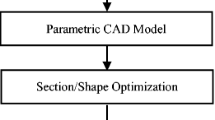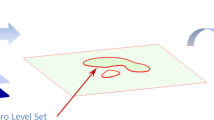Abstract
Medial axis transform of a pocket with free-form closed boundaries is a completed, compact representation of the pocket geometric shape and topology. It is very useful to multiple cutters selection and their tool paths generation for CNC machining of complex pockets. In the past decades, much research has been successfully conducted on the topic of finding the medial axis of a shape domain bounded with a polygon or simple geometries, e.g., lines and circles. Currently, more pockets with free-form boundaries are adopted in mechanical parts; however, the prior medial axis generation methods cannot handle this type of pockets well, resulting in long computation time and low medial axis accuracy. To address this problem, an efficient, accurate approach to calculating the medial axis transforms of these pockets is proposed in this work. An original optimization model of bisectors is established, and a new optimization method—the hybrid global optimization method—is developed to efficiently and accurately solve the optimization model of bisectors. The new optimization model and solver have been applied to many examples, and the testing results have demonstrated the advantages of this innovative approach over the prior medial axis methods. It can be an effective solution to the medial axis transforms of complex pockets.












Similar content being viewed by others
References
Chen ZC, Fu Q (2011) An optimal approach to multiple tool selection and their numerical control path generation for aggressive rough machining of pockets with free-form boundaries. Comput Aided Des 43(6):651–663
Sherbrooke EC, Patrikalakis NM, Wolter F (1996) Differential and topological properties of medial axis transforms. Graphical Model Image Process 58(6):574–592
Choi HI, Choi SW, Moon HP (1997) Mathematical theory of medial axis transform. Pac J Math 181:57–88
Farouki RT, Johnstone JK (1994) The bisector of a point and a plane parametric curve. Comput Aided Geom Des 11:117–151
Farouki RT, Ramamurthy R (1998) Specified-precision computation of curve/curve bisectors. Int J Comput Geom Appl 8(5–6):599–617
Elber G, Kim MS (1998) Bisector curves of planar rational curves. Comput Aided Des 30(14):1089–1096
Culver T, Keyser J, Manocha D (2004) Exact computation of the medial axis of a polyhedron. Comput Aided Geom Des 21(1):65–98
Aurenhammer F (1991) Voronoi diagrams—a survey of a fundamental geometric data structure. Comput Surv 23(3):345–405
O’Rourke J (1998) Computational geometry in C. Cambridge University Press, New York
Fabri A (2007) Voronoi diagrams in CGAL, the computational geometry algorithms library. In:The 4th International Symposium on Voronoi diagrams in science and engineering July 9–11, pp 8–11
Brandt JW (1994) Convergence and continuity criteria for discrete approximations of the continuous planar skeleton. CVGIP Image Underst 59(1):116–124
Dey TK, Zhao W (2004) Approximate medial axis as a Voronoi subcomplex. Comput Aided Des 36(2):195–202
Chou JJ (1995) Voronoi diagrams for planar shapes. IEEE Comput Graphics Appl 15(2):52–59
Ramamurthy R, Farouki RT (1999) Voronoi diagram and medial axis algorithm for planar domains with curved boundaries I. Theoretical foundations. J Comput Appl Math 102(1):119–141
Ramamurthy R, Farouki RT (1999) Voronoi diagram and medial axis algorithm for planar domains with curved boundaries II: detailed algorithm description. J Comput Appl Math 102(2):253–277
Alt H, Cheong O, Vigneron A (2005) The Voronoi diagram of curved objects. Discret Comput Geom 34(3):439–453
Seong JK, Cohen E, Elber G (2008) Voronoi diagram computations for planar NURBS curves. In: Proceedings of the 2008 ACM Symposium on solid and physical modeling, pp 67–77
Gursoy HN, Patrikalakis NM (1992) An automatic coarse and fine surface mesh generation scheme based on medial axis transform I. Algorithms. Eng Comput 8(3):121–137
Gursoy HN, Patrikalakis NM (1992) An automatic coarse and fine surface mesh generation scheme based on medial axis transform II. Implementation. Eng Comput 8(4):179–196
Hassouna MS, Farag AA (2005) Robust centerline extraction framework using level sets. In: The 2005 IEEE Computer Society Conference on Computer Vision and Pattern Recognition June 20–25, vol I, pp 458–467
Alichholer O, Aigner W, Aurenhammer F, Hackl T, Juttler B, Rabl M (2009) Medial axis computation for planar free-form shapes. Comput Aided Des 41:339–349
Kosinka J, Juttler B (2007) MOS surfaces: medial surface transforms with rational domain boundaries. In: Proceedings of the 12th IMA International Conference on mathematics of surface, vol XII, pp 245–262
Kennedy J, Eberhart R (1995) Particle swarm optimization. Anon IEEE, Perth, vol 4, pp 1942–1948
Bratton D, Kennedy J (2007) Defining a standard for particle swarm optimization. In: The 2007 IEEE Swarm Intelligence Symposium April 1–5, pp 120–127
OpenCASCADE. http://www.Opencascade.Org
Author information
Authors and Affiliations
Corresponding author
Rights and permissions
About this article
Cite this article
Chen, Z.C., Fu, Q. An efficient, accurate approach to medial axis transforms of pockets with closed free-form boundaries. Engineering with Computers 30, 111–123 (2014). https://doi.org/10.1007/s00366-012-0295-5
Received:
Accepted:
Published:
Issue Date:
DOI: https://doi.org/10.1007/s00366-012-0295-5




